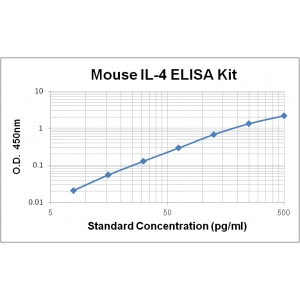More info
|
Assay Range |
7.8 - 500 pg/mL |
|
Sensitivity |
1.0 pg/mL |
|
Size |
96T |
|
Storage |
Store at 2 - 8ºC. Keep reconstituted standard and detection Ab at -20 ºC |
|
Assay Principle |
Sandwich ELISA |
|
Sample Volume |
100 µL final volume, dilution factor varies on samples |
|
Detection Method |
Chromogenic |
Kit Components
1. Recombinant Mouse IL-4 : 2 vials
2. One 96-well plate coated with Mouse IL-4 Ab
3. Sample diluent buffer: 12 ml — 2
4. Detection antibody: 130 µL, dilution 1:100
5. Streptavidin-HRP: 130 µL, dilution 1:100
6. Antibody diluent buffer: 12 mL x1
7. Streptavidin-HRP diluent buffer: 12 mL x1
8. TMB developing agent: 10 mL x1
9. Stop solution: 10 mL x1
10. Washing solution (20x): 25 mL x1
Background
Interleukin 4 (IL-4), also known as B-cell stimulatory factor 1 (BSF-1), Binetrakin, Lymphocyte stimulatory factor 1, Pitrakinra, is a cytokine belonging to the IL-4/IL-13 family. Human IL-4 is synthesized as a 153 amino acid (aa) precursor protein containing a 24 aa signal peptide and a 129aa mature protein. At the amino acid sequence level, mature human IL-4 is approximately 50% identical to mouse IL-4 and shows no species cross-reactivity in mice. Human IL-4 and human IL-13 share approximately 30% sequence identity and exhibit overlapping biological activities.
IL-4 transduces its signals by binding to two specific receptor complexes. One type of functional IL-4 receptor complex consists of the IL-4 receptor (IL-4 R) and the common γc chain which also is a component of the receptor complexes for IL-2, IL-7, IL-9, and IL-15. It has also been proposed that IL-4 might bind to another type of functional IL-4 receptor complex, consisting of the IL-4 R and the IL-13 Rα which also serves as a receptor complex for IL-13. In addition to the membrane-bound form of IL-4 R, a naturally occurring soluble form of IL-4 R has been identified in human and mouse biological fluids and in mouse cell culture supernatants. IL-4 plays an important role in regulation of isotype switching, differentiation of precursor T helper cells to the Th2 and induction of IgE production in B lymphocytes. In addition, IL-4 has also been shown to have anti-tumor activity both in vivo and in vitro.


